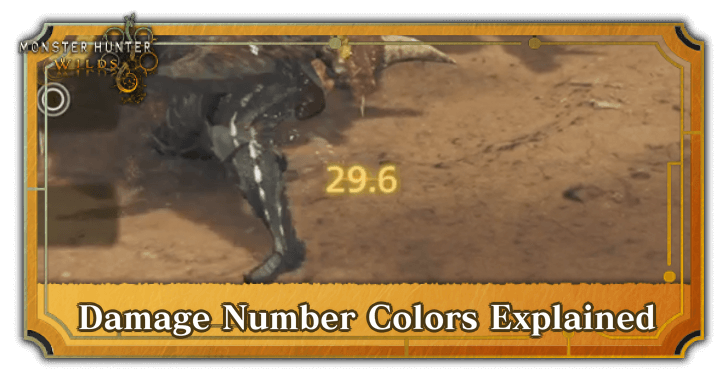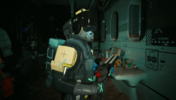Damage Number Colors Explained

Damage numbers in Monster Hunter Wilds can mean different things depending on their color. Find out what damage number Colors mean along with the blue shield icon when fighting Uth Duna and what affects damage in this guide!
Damage Number Colors Explained
White: Low Damage Attack
A White Damage Number Color is the weakest damage color that a hit can produce. This is can be caused by hitting a monster part that resists your weapon's damage type, so try hititng other parts if your damage feels low.
Yellow: Weak Point Damage
Attacks producing Yellow Damage Numbers means that they're hitting a monster part that your damage is effective against. Aim to go for these monster weak points as much as possible during a hunt.
Red: Wounded Part Damage
Red Damage Numbers means that you're hitting a monster wound. These hits have additional arrow indicators, and deal boosted damage because of the wound.
Cream: Additional Damage From Skills

Damage numbers glowing with a cream color indicate extra damage from the skills Scorcher, Bad Blood, and Whiteflame Torrent.
Yellow with Blue Outline: Dragon Blight
If your damage numbers show as light yellow with a blue outline, you have been afflicted by Dragon Blight. While afflicted, your weapon attacks do not deal any elemental damage.
Blue Shield: Uth Duna Veil Damage

Uth Duna has a unique skill of covering parts of its body with a water veil, which decreases 50% of the damage that it takes from weapon attacks.
Hitting these parts will show Blue Damage Numbers with a shield icon, which means that the part being attacked is protected by a veil. Continuously damaging these parts will eventually remove the veil and allows the body parts to take full damage.
Factors that Affect Damage Numbers
Sharpness Level
Your weapon's Sharpness, displayed in the upper-left corner as a sword-shaped gauge, can affect your Damage Numbers regardless of what part you hit on a monster. Remain mindful and sharpen when necessary!
Critical Distance

For ranged weapons, Critical Distance is what can affect your Damage Numbers. Each ranged weapon has a specific distance that does maximum damage to monsters, indicated by the reticle changing appearance.
When not within Critical Distance range, attacks will end up as White Numbers with lower damage. Take note of your weapon's Critical Distance and aim to always fight at its range to produce better damage hits.
Monster Part Breaks and Wounds
Monsters have breakable parts that can be broken to potentially increase your Damage Numbers against that part. Things like shells or armor can start off yielding only White hits, but when broken, can lead to Yellow numbers.
Protective Skills

Some monsters, like Uth Duna, may use an ability to give its body protection against attacks, reducing the damage it takes.
These will eventually be chipped away if the monster takes enough damage, allowing it to take full damage.
Monster Hunter Wilds Related Guides

All Game Mechanics Guides
Comment
There still have a reddot below dmg number. Idk what its mean
Author
Damage Number Colors Explained
Rankings
Gaming News
Popular Games

Genshin Impact Walkthrough & Guides Wiki

Umamusume: Pretty Derby Walkthrough & Guides Wiki

Where Winds Meet Walkthrough & Guides Wiki

Pokemon Legends: Z-A Walkthrough & Guides Wiki

Honkai: Star Rail Walkthrough & Guides Wiki

Wuthering Waves Walkthrough & Guides Wiki

Digimon Story: Time Stranger Walkthrough & Guides Wiki

Pokemon TCG Pocket (PTCGP) Strategies & Guides Wiki

Clair Obscur: Expedition 33 Walkthrough & Guides Wiki

Chaos Zero Nightmare Walkthrough & Guides Wiki
Recommended Games

Diablo 4: Vessel of Hatred Walkthrough & Guides Wiki

Fire Emblem Heroes (FEH) Walkthrough & Guides Wiki

Yu-Gi-Oh! Master Duel Walkthrough & Guides Wiki

Elden Ring Shadow of the Erdtree Walkthrough & Guides Wiki

Super Smash Bros. Ultimate Walkthrough & Guides Wiki

Monster Hunter World Walkthrough & Guides Wiki

Pokemon Brilliant Diamond and Shining Pearl (BDSP) Walkthrough & Guides Wiki

The Legend of Zelda: Tears of the Kingdom Walkthrough & Guides Wiki

Persona 3 Reload Walkthrough & Guides Wiki

Cyberpunk 2077: Ultimate Edition Walkthrough & Guides Wiki
All rights reserved
©CAPCOM
The copyrights of videos of games used in our content and other intellectual property rights belong to the provider of the game.
The contents we provide on this site were created personally by members of the Game8 editorial department.
We refuse the right to reuse or repost content taken without our permission such as data or images to other sites.




![Ashes of Creation Review [Early Access] | A Shaky First Step Into Verra](https://img.game8.co/4366732/e198b3de527af5a399abe4a83d71763f.jpeg/show)


![PRAGMATA Review [Demo] | A Star in the Making](https://img.game8.co/4366752/6f1f137aa669bbea20b6bff53a039ead.png/thumb)




















Hello! We're not sure about the red dots below the damage numbers, but the red dots that appear above indicate a critical hit! Your chances of landing a critical hit depend on your Affinity stat. The higher it is, the more likely you are to deal critical damage. If you'd like to learn more about Affinity, feel free to read about it on our page here! https://game8.co/games/Monster-Hunter-Wilds/archives/500335